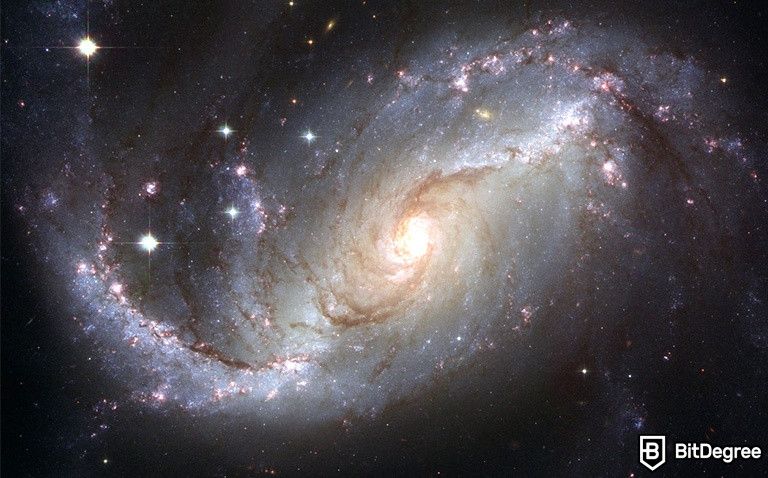Stop overpaying - start transferring money with Ogvio. Join the waitlist & grab early Rewards NOW! 🎁
You probably look at stars every night. But how do you actually study them, instead of just looking at the sky? With numerous online learning platforms available, an online astronomy degree is incomparably closer than those stars in the night sky.
Astronomy classes are not just about the stars, though. They're also about planets, moons, comets — even galaxies and the universe itself. They try to explain the origin, history, and evolution of all celestial objects. And in a way, they explore the origin of ourselves, of our life here, and of our whole world.
Even such early civilizations as Babylonians, Egyptians, Maya, and many others were already making observations about the sky. As time went by and science improved, we are now using more scientific methods and devices, but in essence, we’re all still doing the same thing. We’re trying to figure out how everything works.
With these recommendations for both premium and free online astronomy courses, your academic journey through space and time will be a fun one.
Table of Contents
- 1. Astronomy vs. Astrology
- 2. Branches of Astronomy
- 3. Backyard Astronomy (Enroll Here)
- 4. Astronomy: Exploring Time and Space (Enroll Here)
- 5. Astrophysics (Enroll Here)
- 6. From the Big Bang to Dark Energy (Enroll Here)
- 7. Physics of Astronomy: Orbital Motion & Kepler's Laws (Enroll Here)
- 8. Super-Earths and Life (Enroll Here)
- 9. Astronomy: Eclipses Prediction (Enroll Here)
- 10. Conclusions
Astronomy vs. Astrology
Let’s start with some basic info. I myself used to always confuse astronomy with astrology. They both deal with the stars and other celestial bodies, but overall they are very different subjects. Since you're going for an online astronomy degree, it's definitely beneficial to know the difference between the two, right?
Latest DataCamp Coupon Found:Astronomy is a natural science that studies celestial bodies and their properties. Astrology concerns how the positions of those celestial bodies impact human lives. The way I learned to remember the difference is in their names.
Astronomy has the part -nomy, which sounds similar to the word ‘name’. There are many (88, in fact) constellations with various fancy Latin names. Therefore, it’s the one about the stars in the sky and how they formed and why we see them, etc.
Astrology has the part -logy, which makes me think of the word ‘logo’ — as in a company logo. Usually, the main association with astrology is a zodiac sign or a horoscope. And each zodiac sign has an accompanying picture, as if it was its company logo. Therefore, this is the one about the zodiacs.
Branches of Astronomy
Based on what subject you observe, there are 3 main branches of astronomy. Astrobiology studies the origins, evolution, and future of life in the universe. The main aspect of it is analyzing the conditions for extraterrestrial life. But aliens (no, not the ones Sting sang about) are only a part of it.
This branch of astronomy also examines the biosphere of other planets, analyzing the possibility of life there. This would also help determine if humans could live on other planets.
Astrophysics applies principles of physics to astronomical objects and events. For the most part, it examines the structure, chemical composition, and behavior of planets or some other celestial bodies.

This branch is probably the most common one, and arguably the most impactful on our understanding of how the universe works[1]. It also does a tremendous amount of analysis on more confusing subjects, like properties of dark matter, black holes, or the origin of the universe.
Therefore, studying this branch would be very useful for your online astronomy degree.
The third branch is planetary science (though I personally like its alternative name of ‘planetology’ way more). Planetary science studies how the planets, natural satellites (i.e. moons), and planetary systems have formed in their beginning.
The other way to distribute astronomy branches is not by what they study, but by how they study it. There are four branches based on this aspect:
- Astrometry
- Observational astronomy
- Photometry
- Spectroscopy
Astrometry is the science that tries to precisely measure the positions and movements of the planets and other celestial bodies. Essentially it's the science, due to which we can create star maps and know how celestial bodies move.
If you think of statistics within astronomy, that’s what observational astronomy is about. It deals with recording data of the observable universe. It is believed that this astronomy branch started when Galileo looked through a telescope and recorded what he saw in the sky.
This is the branch that has quite a few subcategories of itself. I’m not gonna tire you out with all of them, but several can be mentioned for general curiosity. There’s optical astronomy, which uses mirrors or lenses to record various wavelengths (not just visible-light ones).

There’s radio astronomy, which uses radio-like receivers to detect radiation. And then there’s occultation astronomy, which focuses on the eclipses and the exact moment they happen. That’s among the coolest ones, don’t you think?
Something that probably all of us notice the most in the sky is how the moon or the stars shine at night. If you’re interested specifically in that, you may consider getting your online astronomy degree in photometry. Yes, that’s the astronomy branch that deals with how light travels through substances or how intense that light is.
Spectroscopy is an astronomy branch, used in several other fields like chemistry, physics, or medicine. This is the science of how various substances react to electromagnetic radiation.
After knowing all that, you now fell in love with either a specific branch of astronomy or with astronomy overall. Great, this makes it the perfect timing to dig into options for achieving your online astronomy degree.
Backyard Astronomy (Enroll Here)

- Platform: Udemy
- Duration: 1h 18min
- Price: €19.99
- Certificate: YES
- Level: Beginner
- Discount: Available
- Apply HERE
This is one of the best astronomy classes online to start with for your online astronomy degree. This course will teach you how to observe the stars, the planets, and other celestial bodies simply from your backyard. Just as the title says.
The lectures start with a simple overview of the sky, and what celestial bodies you can find there. Once you’re familiar with those, you will be explained how the sky moves. The course will even include software to use for simulating the night sky.
After that, you will learn how to read a star chart. Finally, the course will review the instruments or devices to use for the best night sky viewing.
The instructor of this online astronomy course is a full-time cruiser and entrepreneur Rod Miller. He has a long experience in IT, but when the economic conditions changed, he made drastic changes to his life as well. Now he is living and working from his boat, enthusiastic about teaching others.

He has 2 astronomy classes online on the Udemy platform. His second course is Backyard Astronomy II. So if you enjoyed either this course, or the lecturer, feel free to check it out and enroll in the second part as well.
The class is divided into 24 lectures, with a total duration of about 80 minutes. The specific lectures are segmented in a very convenient way. Most of the lessons are under 10 minutes, so you don’t have to be actively stuck to this course, but instead can easily have it on the go.
Backyard Astronomy has an average 4.5/5 rating, with over 3,800 students enrolled. Most of the reviews said the course was easy to follow and the material was interesting to learn.

“Last night i looked at the moon & was amazed to see all the things the course pointed out in the moon lesson. it was fascinating & made me eager to learn more.” — Natalie Corner
The price for this online astronomy degree course is €19.99. That is the standard price for a shorter course like this on the Udemy platform.
After completing this course, you will know:
- What celestial objects you can view with the naked eye
- The celestial coordinate system
- Specifications for a quality telescope
Start the course NOW.
Astronomy: Exploring Time and Space (Enroll Here)
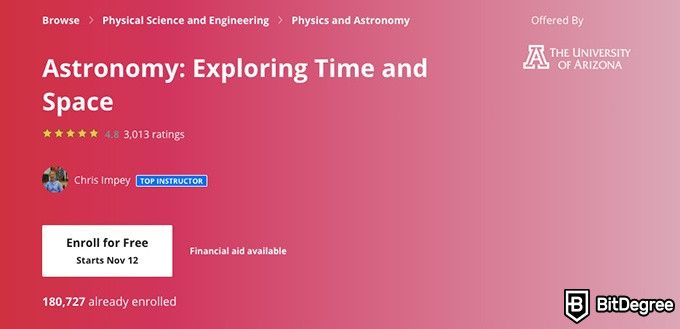
- Platform: Coursera
- Duration: about 43 hours
- Price: from $49 per month
- Certificate: YES
- Level: Beginner
- Discount: Available
- Apply HERE
This course is meant as both a general introduction to the discipline and a review of astronomy’s history. The material starts with talking about astronomy’s vision and imagination.
It also discusses the history of astronomy and the achievements of such historical astronomy contributors as Copernicus, Kepler, or even Galileo Galilei. These scientists created grounds for what we know about astronomy today, and seeking an online astronomy degree is now so much easier due to their discoveries.
It does also cover several celestial bodies and their movement in the sky. The course then continues with an extensive review of various tools for observing the universe and discussing the radiation.
There are several sections dedicated to the Solar system, exoplanets, star life cycles, and galaxies. It finishes off discussing life in the universe overall.
The course instructor Chris Impey is a Distinguished Professor of Astronomy at University of Arizona. His achievements include 11 teaching awards, and a grant from NASA itself. He has written numerous publications on cosmology and astrobiology, and has published several science books on the same topics.

If you are interested, Chris has another course on the Coursera platform to help you on your journey to the online astronomy degree. This course focuses more on astrobiology and exploring the potential of life on other planets.
The course is divided into 11 sections, ranging from 2 to 5 hours per section. This means in total you would spend about 43-44 hours on this course. Almost every section is accompanied by a quiz and sometimes even a practical exercise.
The course has a 4.8 average rating and about 97.5% have ranked it as 4 or 5 stars. Most reviews state the course is easy to understand and to follow. Others complimented the lecturer and his passion for the subject.
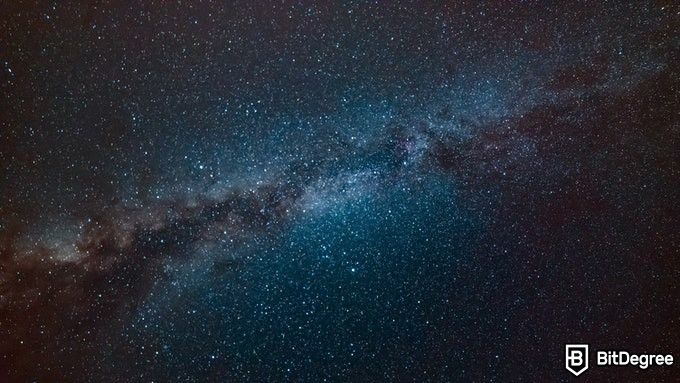
“A terrific experience! Ever since I can remember I’ve been interested in astronomy. It’s been simply amazing to learn all these new things. I really didn’t want the course to end. I guess I’m addicted now! So I have to keep going and take more courses. Thank you for inspiring me to learn more Professor Impey!” — Sam & M
Coursera prices start at $49 a month for a single course. For a course of this length, this is an absolute steal. It averages out only slightly above 1 dollar per hour!
If you want to turn it into one of the free online astronomy courses — you can. There is a free audit option available. However, have in mind that in such case you would not be able to access the practical assignments or quizzes and you would not receive the certificate.
At the end of this online astronomy course, you will have learned about:
- History of astronomy
- The Solar system and stars’ lifecycle
- Life and technology in the rest of the universe
Start the course NOW.
Astrophysics (Enroll Here)

- Platform: edX
- Duration: 80-160 hours
- Price: $200 (now only $180)
- Certificate: YES
- Level: Intermediate
- Discount: Available
- Apply HERE
Astrophysics is actually one of the most common courses (either as required material, or as an elective) for an online astronomy degree. This program consists of four courses that cover various topics of astrophysics:
- Greatest Unsolved Mysteries of the Universe
- Astrophysics: Exploring Exoplanets
- Astrophysics: The Violent Universe
- Astrophysics: Cosmology
The first course in this program for astronomy classes is meant to educate about the biggest mysteries of the universe. Well, at least about the ones that are understood, because many of them still have not been actually solved by scientists.
Don’t worry — not having answers to such a complicated subject like the whole universe is perfectly normal. Just like not yet having an online astronomy degree. We still don’t know exactly why or how the initial creation happened, where are some of the old stars, how black holes expand so much, and so many other mysteries.
This online astronomy course will teach you what are the biggest mysteries in astrophysics at the moment, why is it so difficult to solve them, and what partial progress we have regarding it so far.
The second class is all about exoplanets. These are planets outside our Solar System. In this course you will learn what methods are used for finding and studying exoplanets. You will also learn what information we have about them at the moment and what approaches scientists use to deal with problematic situations.

The Violent Universe course is about the dangerous and mysterious part of our universe. The violence that the course title refers to, is not as worrisome as it sounds. It simply means the course material will teach you about the explosion of stars and other violent chemical matters within the cosmos.
Cosmology is a “branch of astronomy that deals with the origin, structure, and space-time relationships of the universe”. And that’s what this course will be about. Well, mostly. It will once again focus on the yet unsolved mysteries within the topic, but also on what new developments we have, helping to explain those mysteries.
This course involves two guest speakers — Lawrence Krauss and Brian Cox. Brian is actually one of my favorite scientists, and I can promise you — you’re in for a scientific treat. I highly recommend his work, even if you change your mind about getting an online astronomy degree.

Aside from guest speakers, the program is taught by two instructors from Australian National University (ANU). Brian Schmidt was the leader of the team who discovered dark energy. For this, he was awarded the Nobel Prize for Physics in 2011. I doubt I have ever heard of higher credentials for a teacher, have you?
His co-lecturer Paul Francis has worked with NASA and discovered that some black holes are actually pink. He has researched not only comets, but also giant space blobs.
The course is calculated to last 10 months, with about 2-4 hours per week spent on it. If you prefer to count the duration of your astronomy classes in pure hours, that totals up to between 80 and 160 hours. This is a superb extensive program, covering multiple subjects of astrophysics, so extensive learning is to be expected.
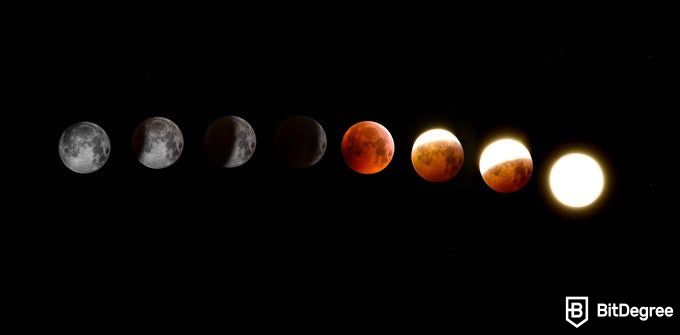
The full program costs $200 (discounted to $180 at the time of writing). A program, lasting for 10 months, taught by such competent educators and scientists? That’s beyond being a bargain, that’s close to being a giveaway.
If you want to take only one or some of the courses individually, you can do that too. Each individual course is priced at $50. This makes the current discount for the full program an even better catch. You can also treat them as free online astronomy courses — free audit option is available.
However, do have in mind that with the free audit track, you will access only the theoretical materials, but won’t be able to make use of practical assignments. Even more, you would not get the certificate of completion. So while you would have the knowledge, you wouldn’t have the credentials of an online astronomy degree.
By the end of this program, you will have learned:
- What are the biggest mysteries in the universe and why it’s so difficult to solve them
- Methods to study exoplanets and results from those studies
- Several types of stars and black holes, and related explosions
Start the course NOW.
From the Big Bang to Dark Energy (Enroll Here)
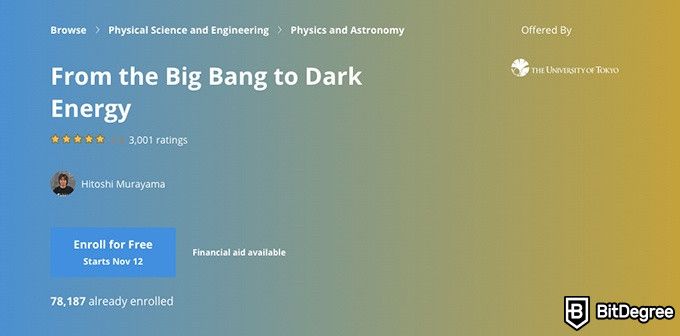
- Platform: Coursera
- Duration: ~30 hours
- Price: from $49 per month
- Certificate: YES
- Level: Beginner
- Discount: Available
- Apply HERE
Are you a fan of the TV show “The Big Bang Theory”? If so, this topic may feel closer to home or more appealing.
This online astronomy course focuses on the Big Bang and, more specifically, its implications. The lectures start with an overview of how the Earth developed. They continue with discussing the birth of various chemical elements, and the Higgs Boson particle.
These topics will ease you into the main point of this course — discussion of dark matter, anti-matter, and dark energy. All these different matters played a crucial role during the formation and expansion of the universe, but there is still so much we have to learn about them.
This course for an online astronomy degree is presented by Hitoshi Murayama from the University of Tokyo. Hitoshi is a professor of Physics, he is a Fellow of the American Physical Society and is known for his clear lectures.

The course is divided into 4 weeks of material, ranging from 7 to 9 hours during each week. You are able to stud at your own pace though, as you can reset the deadlines within this course. This totals to about 30 hours of study time.
The course for an online astronomy degree has an average rating of 4.8/5, with over 97% of the ratings being 4 or 5 stars. That’s a really impressive score. Most comments praised both the lecturer and the content. They said professor Murayama was engaging and made complex topics easy to understand.
“The presentation style and examples help me broaden my understanding of the big bang, dark energy and dark matter. I can recommend this course to anyone who is looking to gain a greater understanding on the universe.” — Ray G
Coursera courses, including astronomy classes, start at $49 per month. You can audit the course for free as well, but that would include only the theoretical portion and would not grant you the certificate.
After completing this course, you will have learned about:
- The birth and history of the universe
- Importance of Higgs Boson
- Dark matter, anti-matter, and dark energy
Start the course NOW.
Physics of Astronomy: Orbital Motion & Kepler's Laws (Enroll Here)

- Platform: Udemy
- Duration: 10h 20min
- Price: €49.99
- Certificate: YES
- Level: Intermediate
- Discount: Available
- Apply HERE
The main principle throughout this online astronomy degree class is to use classical physics concepts and apply them to astronomical phenomena. Due to this, previous experience or at least exposure to physics (and specifically, Lagrangian Mechanics) is highly recommended.
The course title mentions Kepler’s laws. Just in case you’re not yet familiar with them — Johannes Kepler was a German astronomer, who in the early 17th century developed laws of planetary motion.
The course will start with teaching you how to develop the essential models of mechanics or physics, in order to describe the planetary motions within the orbit. It will then follow up with instructions on how to interpret those results. The third part of the course will focus on joining physics and astronomy concepts.
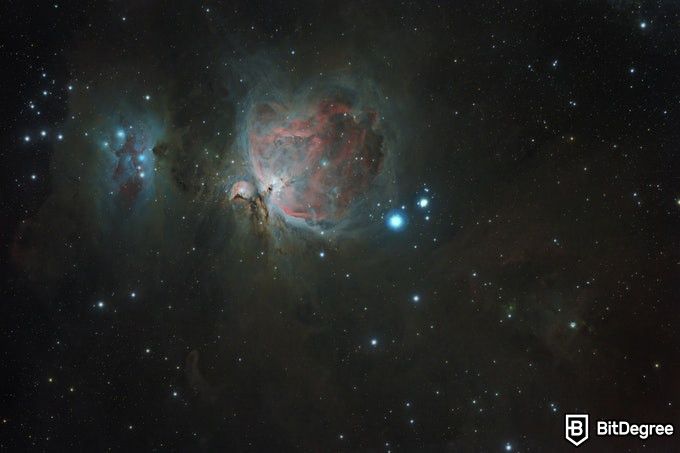
Course instructor Edward Reilly is a physics professor and a motivational speaker. He has 2 bachelor's and 1 master's degrees in the physics field. If you got interested in what else he has to offer aside from this online astronomy course, he has 3 more courses available.
The course lasts for a bit under 10 and a half hours, and is divided into 38 lectures. Each lecture is from 10 to 30 minutes, so you can still conveniently learn at your own pace.
This class has a 4.7/5 average rating, with 81% of evaluations being 4 or 5 stars. Reviewers were fascinated by the way Edward teaches and were looking forward to taking more courses, taught by him.

“I really like the content so far. Mr. Reilly is enthusiastic and clearly knows the subject. I’m looking forward to the rest of my studies in orbital mechanics with him.” — Zachary B. Milne
The course is currently priced at €49.99. Very reasonable price for a course that’s over 10-hours. In addition, Udemy often has discounts available, so depending on when you visit their website, you might get an even better deal!
After completing the class, you will gain:
- Extensive understanding of Kepler’s Laws
- Techniques for optimizing analyses
- Knowledge of how to apply classical physics to astronomy concepts
Start the course NOW.
Super-Earths and Life (Enroll Here)

- Platform: edX
- Duration: 45-75 hours
- Price: $99
- Certificate: YES
- Level: Introductory
- Discount: Available
- Apply HERE
To start with, you should probably know what a super-Earth is, cause that’s not your everyday term. Super-earth is a planet outside the Solar System, that has a higher mass than the Earth, but a significantly smaller mass than Uranus or Neptune.
This course aims to showcase how astronomy, biology, and geology combined can assist with answering one of the longest and most prominent questions ever. Is there life outside Earth? Or are we alone?
This course for your online astronomy degree is divided into 7 modules. The modules explain several things and try to answer or at least explain certain questions. These are:
- What is a planet
- How do we find new planets outside the Solar System
- How has the Earth changed and what do those changes mean to us
- How was life created and how it has changed until now
- Habitable planets and searching for a new life there
The course instructor professor Dimitar Sasselov is an expert on astronomy and also, more specifically, astrobiology. Aside from his academic activities at Harvard University, he is a co-investigator on NASA’s Kepler mission.
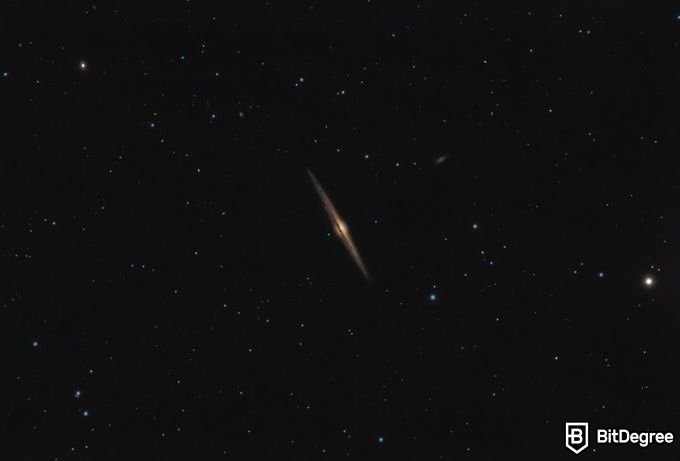
It is estimated to complete the course within 15 weeks. This assumes workload of 3-5 hours per week, but you can progress at your own speed instead.
“Amazing course. It gives a strong foundation on how life might have arisen on Earth, and how to look for other habitable planets in the universe.” — Anonymous
This online astronomy course costs only $99. This is quite a low price, considering the amount of material and the lecturer credentials. You can also get it at an even lower price with our edX coupons.
After completing this course, you will have learned:
- How life developed on Earth
- How we discover planets outside the Solar System
- How we search for life in those other planets
Start the course NOW.
Astronomy: Eclipses Prediction (Enroll Here)

- Platform: Udemy
- Duration: 6h 2min
- Price: €89.99 (now only €12.99)
- Certificate: YES
- Level: All levels
- Discount: Available
- Apply HERE
You’ve probably heard the term “once in a blue moon”. But did you know that such phrase refers to an actual phenomenon? It’s when there’s an extra full moon in a year (usually there is only one per month). And that time interval is quite more frequent than you could have thought — it’s simply every 2-3 years.
A related phenomenon that happens quite more often than one could think (at least more often than I at first thought) is eclipses. There are 2-5 solar and the same amount of lunar eclipses per year. Also, studying the eclipses can help us study the sun or the moon itself[2].
Thus, knowing when they would happen, sounds super useful as well, right? You probably don’t know when eclipses would occur until the time is announced in media. Well, this online astronomy course offers you the opportunity to actually learn to predict eclipses yourself.

This course will teach you how to predict solar and lunar eclipses, to an accuracy of just several minutes. You should have basic knowledge of mathematics and astronomy, but other than that, no prior competence is required.
The course instructor Muhammad Shafique comes from Civil Engineering discipline. He’s responsive to students’ messages and his motto is “I am here to make it clear”, which does reflect in his courses as well.
The class has 38 lectures and lasts for about 6 hours. It presents three methods for predicting eclipses: manual, semi-automatic, and automatic. Each method has several projects attached to it, so that you can test your knowledge right away.
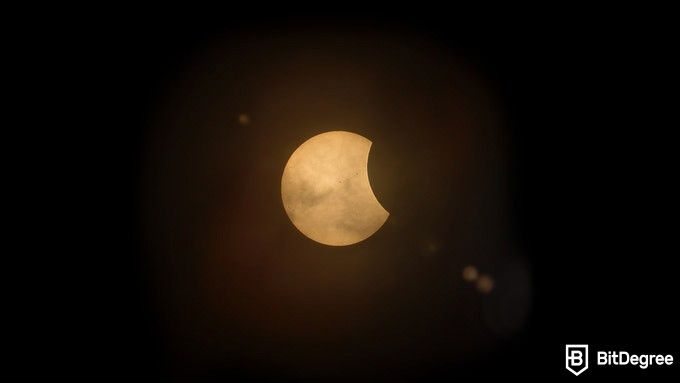
This course has a perfect 5.0 score rating! There is only a handful of reviews, but those students felt the course was very useful and the lecturer radiated competence.
“The Instructor is an experienced person. He teaches Eclipse prdictions in excellent way. I have learnt all the lessons from this astronomy course and now, I can predict eclipses manually. I am waiting for another similar course from him.” — Muhammad Adnan
The usual price of this course is €89.99, but right now it’s only €12.99. For a course so extensive, the discounted price is an absolute catch!
After completing this online astronomy degree class, you will know how to:
- Distinguish different types of eclipses
- Predict lunar and solar eclipses with an accuracy of several minutes
- Use three different methods for such predictions
Start the course NOW.

Did you know?
Have you ever wondered which online learning platforms are the best for your career?
Conclusions
Interest in celestial bodies has been present already in ancient civilizations. Up to this day, we keep studying the universe and its secrets, we just now have better gadgets and a better understanding of how to do so. With an online astronomy degree, you can also skyrocket your future to astronomical heights.
The most useful astronomy classes online can be found on Udemy, edX, and Coursera. These are some of the best online learning platforms in the market at the moment. Aside from having premium classes, they also have options for free online astronomy courses.
Whichever course or courses you choose from these handpicked recommendations, their quality and excellence should take you over the moon.
Scientific References
1. D W Savin, N S Brickhouse, J J Cowan, et al.: 'The impact of recent advances in laboratory astrophysics on our understanding of the cosmos'
2. Stanley David Gedzelman: 'Solar eclipse skies and limb reddening'
